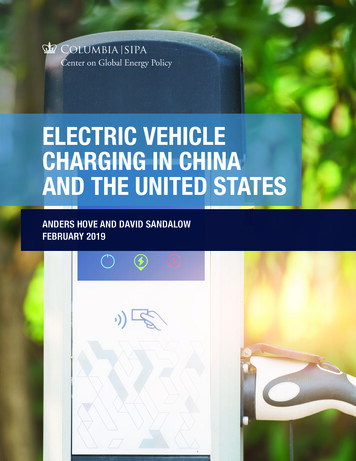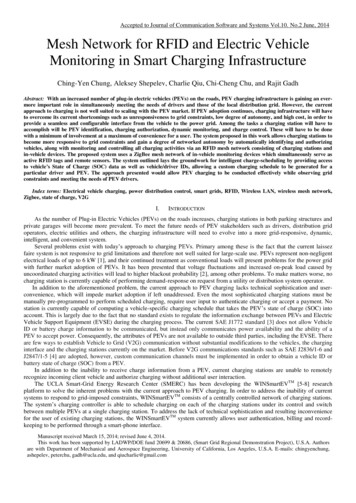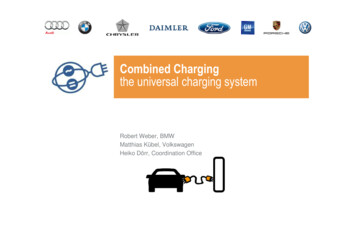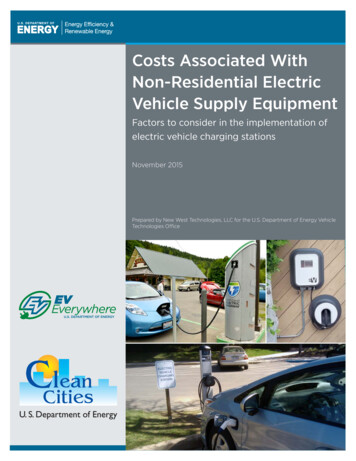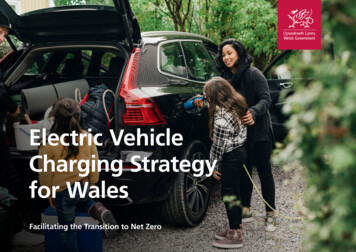
Transcription
Electric VehicleCharging Strategyfor WalesFacilitating the Transition to Net ZeroElectric Vehicle Charging Strategy for Wales1
ContentsForeword 31. Executive Summary42. Vision and Scope63. Background and Context74. Current Charging135. Future Charging Needs of Wales196. Drivers of Change307. Summary and Key Outcomes338. Action Planning 34Electric Vehicle Charging Strategy for Wales2
CroesoCroesoFrom the MinisterKen Skates MSMinister for Economy,Transport and North WalesThis strategy sets out ourvision for electric vehiclecharging in Wales. Thankyou to everyone who hasparticipated in shaping thisstrategy, through consultationon the draft. There has beenwidespread commitment tocollaborative working to deliverour vision for charging acrossWales. The vision, underpinnedby the Well-being of FutureGenerations (Wales) Act 2015,‘reflects our commitment toinclusivity’.A ban on the sales of new petroland diesel only cars and vans willbe introduced in 2030. This placesgreater emphasis on the urgencyof the challenge for a transportrevolution for Wales. It supportsour aspiration to end Wales’contribution to climate change byElectric Vehicle Charging Strategy for Wales2050, and to improve the qualityof the air that we breathe.Llwybr Newydd: a new WalesTransport Strategy sets out mylong term vision for an efficienttransport system that makesa positive contribution to theeconomy, to social justice and toour health and well-being, in away that reduces carbon emissionsand the impact of transporton our environment. We wantto increase the use of publictransport in Wales and encouragemore cycling and walking butwe also recognise that electricvehicles will play an importantpart in the future of transport.Electric vehicles will bring benefitsto consumers, in lower runningcosts and the ability to chargeat a variety of locations but werecognise that providing chargingfacilities to meet the needs ofelectric vehicle users will be abig challenge. There are clearcommercial opportunities tomeet this demand but we willalso need to invest in order todeliver our vision of a networkof electric vehicle charging thatenables consumers to confidentlyswitch from combustion to electriccars and vans. The strategy isintended to support the public,private and third sector, as well asindividuals, providing a commonframework for understandingand collaboration. The strategywill be supported by an actionplan to track and managedelivery, which will be monitoredand reviewed annually.We look forward to continuedcollaboborative working to helpshape the charging infrastructuresystem you need across Wales.3
1. Executive Summary1. Executive SummaryWe have declared a climateemergency and havecommitted to delivery ofWales’ target of net zero by2050. The transport sector, asone of the largest contributorsto greenhouse gas emissionsin Wales, has a significant roleto play.Welsh Government recognise thatthis strategy represents the firststep for Wales to take targetedaction to deliver a vision forelectric vehicle charging that meetsWales’ unique requirements. Thisstrategy sets out where we arenow in providing charging forcars and vans across Wales, ourcharging needs for the decade,and how these can be met.Electric Vehicle Charging Strategy for WalesIt is based on the following vision:A Vision for Charging in WalesBy 2025, all users of electric carsand vans in Wales are confidentthat they can access electricvehicle charging infrastructurewhen and where they need it.Whilst Wales currently has one ofthe lower levels of electric vehicleownership in the United Kingdom,this strategy aims to increase publicconfidence in the availability ofcharging infrastructure which willfacilitate increased ownership.Engagement with existing andprospective electric vehicle usersin Wales has shown that anoverall lack of charging facilitiesand issues with the quality ofthe charging experience havebeen key concerns. We can worktogether to implement morecharging and a better chargingexperience across the country,so that users are confident tomake the switch to electricvehicles. This strategy includesthe UK Government-led initiativesthat apply in Wales, and whereWales can go further to meetour unique and localised needs.Where users can charge carsand vans at home (with accessto off-street parking), this offersthe most convenient and costeffective charging solution. Homecharging presents great potentialin Wales, where many homeshave access to off-street parking.We will introduce requirementsfor new homes to be ready forcharging through changes toBuilding Regulations as well aspromoting the wider supportavailable for those wanting toinstall charging at home.In order to promote equitableaccess to charging we need togo further to support those whoare unable to charge at home.Fast charging is installed at manydifferent types of locations(workplaces, supermarkets,on-street, destinations etc.) andwill be increasingly important forall users of electric cars and vans,particularly those unable to chargeat home. Welsh socio-economicdata has been used to predictthat we need 30,000 to 55,000fast chargers to be availablein Wales by 2030. We plan tointroduce measures that willprovide high quality fast chargingto meet this need, throughpartnerships and collaboration.Rapid charging will also beimportant, especially for longdistance journeys. We will needup to 4,000 rapid chargers tobe installed by 2030. WelshGovernment has started to workwith Transport for Wales to bringforward rapid charging on thestrategic trunk road network.4
1. Executive SummaryBased on policy context, existingand future charging needsand engagement with usersand stakeholders, this strategyhas identified the followingkey conclusions to be takenforward to action planning: The need for a substantialincrease in the number ofslow, fast and rapid/ultra-rapidchargers available in Wales.Meeting the need for up to55,000 fast chargers in Wales,alongside home charging will bea key area of focus to promoteequality of access to charging. The need for better qualitycharging, to improvethe user experience forelectric cars and vans. Sustainable, integrated andcross-sectoral planning willfacilitate the decarbonisationof energy and transport,and create co-benefits.Welsh Governmentcan create favourableconditions for economic andemployment opportunitiesto be captured in Wales.Electric Vehicle Charging Strategy for Wales The supply of power is theresponsibility of electricitynetwork owners and isregulated by UK Governmentand Ofgem. We will workwithin the current regulatoryframework with thesestakeholders to plan for thedecarbonised grid network(including heat, renewableelectricity generation andtransport) so that the needsof charging will be met in away that is efficient for networkmanagement incorporatingsmart technology. This will assistin being ready to capture thebenefits of vehicle to grid.The modelling for predictingcharging needs set out in thisdocument is based on theadoption of fully electric privatevehicles from the ‘Leading theWay’ Future Energy Scenario,modified to account for the 2030ban on the sale of petrol anddiesel cars and vans announcedby the UK Government. A furtheradjustment has been made toaccount for vehicle turnoverin Wales compared to the UKaverage. This has resulted inhigher predicted demand forcharging than was published in theconsultation draft of this strategy.Section 8 provides the basis foran action plan which will bepublished in June 2021 to trackand manage delivery. WelshGovernment recognises itsenabling role in delivering thischarging infrastructure throughthe use of regulatory and planninglevers, as well as land use planningguidance, use of public land andresources, funding, and targetedsupport programmes. Targetedaction planning will be undertakento meet the rapidly growing needfor charging to ensure that alack of electric vehicle charginginfrastructure does not become abarrier to transitioning to electriccars and vans. Welsh Governmentcan create favourable conditionsfor economic and employmentopportunities to be capturedin Wales. It is a key aspirationto develop a framework thatcaptures as much economic activityas possible from the provision,operation and maintenanceof these facilities within theWelsh and local economy.Delivering the aims of thisstrategy will require significantlevels of investment. There areclear commercial opportunities inelectric vehicle charging but werecognise that targeted investmentby government in areas whereprovision is not up to standard willbe necessary. Technological changewill influence the shape of electricvehicle charging infrastructure inthe future, including improvementsin battery technology, micromobility, autonomous vehiclesand hydrogen. These aspectswill be kept under review as partof ongoing action planning.5
2. Vision and Scope2. Vision and ScopeThere is an immediate needfor more charging and bettercharging infrastructure tofacilitate consumer confidencein making the switch toelectric vehicles.The following vision will helpstakeholders plan for charginginfrastructure and their role indelivering or accessing it. Whilstcharging infrastructure can bedelivered by a variety of means,government has an enabling role.Setting the vision is the first step.Electric Vehicle Charging Strategy for WalesVisionA Vision for Charging in WalesBy 2025, all users of electriccars and vans in Wales areconfident that they can accesselectric vehicle charginginfrastructure when and wherethey need it.ScopeThis strategy sets out currentprovision of charging in Wales,the number of chargers, types ofchargers and standards of chargingrequired. The future changes thatshould be considered are alsooutlined. The strategy covers theperiod until 2030, yet we recognisethe urgency of taking action nowto put us on the right path bysetting the vision for 2025. Thisstrategy focusses on cars andvans used by private individuals,businesses and taxis to meetpredicted need of users with themost immediate and measurableneed. As the ban on the sale ofpetrol and diesel cars and vans by2030 applies to hybrid vehicles by2035, this strategy focusses onsupporting the charging needsof cars and vans that are entirelyelectric. In the short term, bettercharging provision will also enablehybrid vehicles to charge.The future of electric chargingwill also need to consider theimpact of market changes.These include the necessarytransition of freight, publictransport and more integratedmulti-modal transport systems.Opportunities for sustainablemodal shifts and integrationwill need to be quantified in thecontext of Llwybr Newydd: anew Wales transport strategy andwill provide important contextfor ongoing action planningfor electric vehicle charging.Other technologies (suchas hydrogen) will in futurehave a role to play alongsideelectrification. The longer termand bespoke charging needsof other vehicle types meansthat further planning will berequired. Whilst these aspectsare outside of the scope of thisstrategy, commentary is providedin Section 6 in order to providecontext. Welsh Governmentis consulting more widely onplanning for the decarbonisationof transport, and will continueto monitor additionalimplications that this may haveon electric vehicle charging.6
3. Background and Context3. Background and ContextWales legislation,policy and plansWelsh Government has set outits legal commitment to achievenet zero emissions by 2050. Weare passing regulations in 2021to set interim targets for 2030,2040 and 2050, against carbonbudgets (2021-25 and 20252030). The transport sector, asone of the largest contributorsto greenhouse gas emissions,has a significant part to play inachieving net zero.Planning Policy Wales (2018)states that we should ensure ourtransportation infrastructure isadaptable to future advances ininnovation (e.g. electric vehicles)and that we should ensureprogress is made towards ashift to low or zero emissionmeans of road transport.In March 2019, the WelshGovernment published “Prosperityfor All: A Low Carbon Wales”1which sets out how Wales aimsto meet its carbon targets.This includes proposals toaddress the adoption of electricvehicles and the requiredcharging infrastructure.The policies aim to: Increase the uptake ofelectric vehicles (includingbattery electric vehicles,hybrids and plug-in hybrid)and promote active travel. Reduce the carbon footprintof buses, taxis and privatehire vehicle fleets to zeroemissions by 2028. Explore the possibility for allnew cars and light goodsvehicles in the public sectorfleet in Wales to be ultra-lowemission by 2025. Wherepracticably possible, all newheavy goods vehicles areultra-low emission by 2030. Invest in public charginginfrastructure.Llwybr Newydd: a new Walestransport strategy sets theframework for decarbonisation ofthe transport sector as a whole.This strategy has been createdto sit within the context LlwybrNewydd as a specialist and prioritytopic area, where urgent actionand cross-sectoral integration(across the energy and transportsectors in particular) is required.Future Wales: The NationalPlan for 2040 sets a 20 yearplan for shaping the growthand development of Walesand provides context for spatialplanning in delivering electricvehicle charging. It notes that‘Planning Authorities should takea strategic approach to electricvehicle charging in their areaand, where appropriate, developpolicies in their development planand specific local requirements.Welsh Government (2019). “Prosperity for All: A Low Carbon Wales”.1Electric Vehicle Charging Strategy for Wales7
3. Background and ContextThe provision of electric vehiclecharging infrastructure shouldbe planned as part of the overalldesign of a development’.These two key points willhelp guide action planningassociated with this strategy.Our vision for charging in Waleswithin this strategy is shaped bythe context of the Well-beingof Future Generations (Wales)Act 2015. The Act providesan important framework forhow we go about meeting thecharging needs of Wales andtake a joined-up approach.United Kingdomlegislation, policyand plansThe Department for Transportis developing a TransportDecarbonisation Plan, which willset out actions for government,business and society to deliver thesignificant emissions reductionneeded across transport. The needto support electrification,Electric Vehicle Charging Strategy for Walesalongside other measures includingdemand reduction, is clear.UK Government and theDepartment for Transport hasstarted investing in electricvehicle charging infrastructure,across a number of plannedprogrammes. The Departmentfor Transport’s ‘Project Rapid’ isplanning to facilitate chargingat Motorway Service Areas. TheUK Office for Zero EmissionsVehicles administer grant fundingschemes for home charging,workplace charging and on-streetcharging, as detailed in Section 4.A public-private sectororganisation, the Zemo wasestablished in 2003, to acceleratethe shift to low carbon vehicles.Their most recent review in 2020,identified three urgent priorities:1. “The urgency of developingstandards and codesof practice to enableinteroperability and thesharing of data within theelectric vehicle sector andwith the electricity system.2. T he need for effective localand national planning andcoordination to enableefficient investment,mediating the balancebetween future-proofingand asset stranding.3. T he criticality of smartcharging; underpinned bya resilient network andclear market signals, toreduce the cost of supplyingmillions of EVs”.Emerging projects and plans arebeing led by the Departmentfor Transport, alongsiderecommendations of the Zemo.They provide a framework for thepublic sector to take action onfacilitating the provision of electricvehicle charging, largely applicableto England. The Automated andElectric Vehicles Act 2018 providesthe UK Government powers tointroduce further measures toregulate and shape future chargingprovision. Section 8 of this strategyadopts and expand upon theprinciples being established inorder to promote coherence anda user experience that meets(and where appropriate exceeds)standards being set across the UK,as well as meeting the additionalunique requirements for Wales.Charging infrastructureElectric vehicle users have a rangeof options as to where, howand when to charge their cars.The patterns that users adopt(known as ‘charging behaviours’)vary according to personalcircumstances and need. The keyinfluencing factors on chargingbehaviours are the time it takesto charge, convenience and cost.Charging at home, where available,is typically the cheapest and mostconvenient form of charging(known as ‘slow’ or ‘trickle’charging). Not all users haveaccess to charging at home, asthis is difficult without a driveway.Most users will require chargingaway from home at some point,especially on long journeys.8
3. Background and ContextAway from home, the type ofcharging most suitable dependson the length of time a user maystay at that location. The costof charging is highly variable,depending on vehicle type,charging type, whether a useris fully charging or topping up,and payment arrangements(such as membership schemesor free charging bundled withother services). Rapid chargingis usually most expensive for theuser, on a pence per kilowatthour basis. Higher poweredcharging provides a faster chargingexperience, and also placesmore demand on the electricitynetwork, hence the higher cost.Certain charging types are typicallysuited to certain locations, asillustrated below and furtherexplained in the following sections.Electric Vehicle Charging Strategy for Wales9
3. Background and ContextHome chargingWorkplace chargingDescription: Home charging is the cheapest and most convenientform of charging, usually slow charging overnight.Description: Workplace charging is typically provided in private carparks. Charging can be slow or fast and offers a convenient way torecharge an electric vehicle for employees and business fleet.Likely target users: Users with off-street parking.Challenges: On existing properties, the onus is on the userto arrange installation. Grants are available via the Office forZero Emission Vehicles Homecharge Scheme. Users can bebetter supported with clear and consistent information.Electric Vehicle Charging Strategy for WalesLikely target users: Employees, business fleet users.Challenges: Parking space availability. May incentivise behavioursto use private vehicles rather than more sustainable transportmodes, where possible. Grant support is available via the Officefor Zero Emission Vehicles Workplace Charging Scheme.10
3. Background and ContextOn-street chargingDestination chargingDescription: Stand-alone pillars, typically ‘fast’ chargers provideon-street charging. Dedicated kerbside charging points havebeen developed that avoid cables trailing across footways.Description: Fast charging is provided at destinations where the usermay park for a number of hours, e.g. gym, cinema or shopping centres.Hotel chains may take advantage of the overnight charging, and use slowcharging as it is more cost-effective.Likely target users: Users with no off-street parking, such as terracedhousing. Visitors to destinations where on-street parking is available.Challenges: Managing parking to ensure that users haveaccess when they need it, and others don’t block spaceswhen not charging. Funding and arranging installation can betime consuming, especially where grid is constrained.Electric Vehicle Charging Strategy for WalesLikely target users: Destination visitors.Challenges: Not strategically planned or managed – based on individualinvestment decisions at destination.11
3. Background and ContextOn-route chargingHub chargingDescription: On-route charging is used to top up midway througha journey, for example at motorway service areas.Description: Hub-based charging can be at centralised or out-of-townlocations. Hubs can include different types of users, as part of a multi-modaltransport strategy. A mix of charging types would be required to servicedifferent user needs. There is the potential for synergies to offer greater value.Likely target users: Business travel users, private leisure users,freight and logistics.Challenges: Market segmentation, resulting in incompatibilityacross charging equipment and supporting payment and datainfrastructure. Lack of strategic planning. Sufficient grid capacitymust be available to accommodate high powered charging.Electric Vehicle Charging Strategy for WalesLikely target users: Taxis, buses, business fleet, park and ride/multi-modaltransport users, car rental companies, freight and logistics.Challenges: Land availability. Grid capacity and cross-sector integration.New delivery models are required to deliver multi-modal transport services.12
4. Current Charging4. Current ChargingThe following provides anoutline of where Wales is in thecontext of the rollout of electricvehicle charging infrastructure.It sets out how the market isdeveloping across differentcharging types. We knowthat we must improve theprovision of electric chargingacross Wales, so that users areconfident to make the switch toelectric vehicles.23Total number of chargepoints in WalesWales currently has one of thelower levels of electric vehicleownership in the UK. Thisstrategy aims to increase publicconfidence in charging, which willfacilitate increased ownership.Public charge points andelectric vehicles licensed per100,000 of population by UKregions2,3Wales is currently behind Englandand Scotland in terms of thenumber of chargers availableand electric vehicle ownership.The relationship between thenumber of chargers availableand electric vehicle ownershipis positive (i.e. more chargingsupports increased electric vehicleownership), but slightly differentfor each part of the UK. Otherfactors such as geography,demographics, prosperity, policyand institutional frameworksare influential, emphasising theneed for this strategy to considercircumstances specific to Wales.Department for Transport (2020). Battery Electric Vehicles or BEV (subset of ULEV) licensed at the end of the quarter by upper and lower tier local authorityDepartment for Transport (11 August 2020). Electric vehicle charging device statistics July 2020Electric Vehicle Charging Strategy for Wales13
4. Current ChargingElectric VehicleMarket Penetration4determined by number of electrical vehicles comparedto the number of total vehicles.4The unique geography anddemographics of Wales framethe challenges that we facein providing better charging.Rural areas and economicallydisadvantaged areas of Walesare particularly underserved, withlarge ‘gaps’ in the rapid chargingnetwork for long distance travel.The following graphic also indicatesvery low numbers of charge pointsin local authority areas aroundthe South Wales valleys, andlocalised differences between localauthority areas. These factors areimportant when defining uniqueactions for Wales in Section 8. 4Department for Transport (2019), Vehicle Licensing Statistics. Available at: icsElectric Vehicle Charging Strategy for Wales14
BlaenauMerthyr GwentTydfill4. Current ChargingNeathPort TalbotNumber and location of chargers in Wales in 20205SwanseaRhonddaCynon ardiffVale ofGlamorganHigher charging demandIsle ofAngleseyFlintshireConwyDenbighshireWrexhamLower charging rthenshireNeathPort TalbotSwanseaBlaenauMerthyr GwentTydfillRhonddaCynon ocal AuthorityCardiffPembrokeshireIsle of hamVale of GlamorganBlaenau GwentFlintshireCeredigionMonmouthshireMerthyr TydfilPowysCaerphillyNeath Port TalbotBridgendTorfaenCarmarthenshireRhondda, Cynon, 23212018161513121187776654322CardiffVale ofGlamorgan5Data extract from Chargepoint Registry July 2020Local AuthorityElectric Vehicle Charging Strategy for 140633315
4. Current ChargingTypes ofchargingin WalesHome chargingAdoption in Wales: As thecheapest and most convenientform of charging, where usershave access to off-street parkingthey will predominantly charge athome. Users are responsible forinstalling their own charge pointat existing properties. There arecurrently a few thousand chargepoints installed at homes in Wales6.Charging at home in Wales offershuge potential, a large proportionof houses in Wales (varying acrosslocal authority areas) have offstreet parking that can be used forthis purpose, although it is hugelyvariable across different partsof Wales. Urban areas in Wales67tend to have more houses withoff-street parking than major UKcities such as London. Over 50%of homes in Cardiff, for example,have access to off-street parking.Delivery in Wales: Residentswishing to install a charge pointcan apply to The Electric VehicleHomecharge Scheme (EVHS)which provides grants of upto 350 per charge point.Direction of travel: The EnergyPerformance Buildings Directive,to be transposed into WelshBuilding Codes (see Section 8),signal the requirement for all newhomes with associated parkingbe ready for electric vehiclecharging. The same obligationis placed on any refurbishmentscheme covered by the Code.A number of energy providersare offering combined electricvehicle charging and homeenergy tariffs. These ‘smarttariffs’ incentivise users to chargeovernight, when electricity canbe cheaper and more efficientfor managing the grid network.The Office for Zero EmissionsVehicles has recommendedthat this be mandated.As more people install homecharging, there will be morepressure on local grid capacity.Smart charging seeks to alleviatepressure through efficient useof the grid network mitigatingpeaks and troughs in load wherepossible. Welsh Governmentwill work with District NetworkOperators (DNO), NationalGrid and Ofgem to promotea regulatory framework. Theframework will allow the electricityindustry to cost effectively deliverthe changes to enable networksto provide the power needed todeliver net zero across Wales.Workplace chargingDelivery in Wales: Employers areprimarily responsible for installingcharging at workplaces, althoughin rented commercial propertiestenants may need to makearrangements with landlords. TheWorkplace ChargePoint Schemerun by the Office for Zero EmissionVehicles provides access to agrant of up to 350 per chargepoint, up to a maximum of 40charge points at each location.Direction of travel: There isan ambition in Wales for publicsector to switch fleet vehiclesfrom combustion to electric assoon as possible. To enable thisto happen we might expect muchmore charging at workplacesto be installed. Many largerbusinesses are seeking to adoptcharging as part of corporatecommitments to net zero.Adoption in Wales: There areapproximately 320 workplacechargers installed in Wales7.3,500 domestic charge points in Wales received grants from the Electric Vehicle Homecharge scheme as of October 2020.Based on the number of charging sockets in Wales supported by the Workplace Charging scheme as of October 2020.Electric Vehicle Charging Strategy for Wales16
4. Current ChargingOn-street chargingDestination chargingAdoption in Wales: There areat least 145 on-street chargersin Wales8Adoption in Wales: There areapproximately 300 destinationchargers, at approximately150 locations across Wales9.Delivery in Wales: Localauthorities are leading the rollout of on-street charging. TheOn-Street Residential ChargePointScheme from the Office for ZeroEmission Vehicles helps localauthorities to part fund the capitalcosts of installation (up to 7500per charge point). The WelshGovernment Local TransportFund is also a source of fundingaccessible to local authorities.Direction of travel: The Officefor Zero Emissions Vehiclesis considering what furtherincentives may be provided insupport of on-street charging.Delivery in Wales: Partnershipsare increasingly being used todeliver electric vehicle charging.In this model, organisationsthat provide goods and servicespartner with a charge pointoperator to provide chargingacross a number of sites. Somesupermarkets, for example haveannounced plans to do this.Direction of travel: Partnershipsbetween automotive organisationsare emerging in order toconsolidate services for boththe physical infrastructureand soft infrastructure (suchas payment and customersupport). Alternative modelsof localised charging includeWelsh community partnerships,such as TrydaNi. Communitypartnerships consolidate a numberof community interest andcommunity energy companies toprovide charging infrastructureto areas in need. It is expectedthat business will continue to leadthe uptake, but that in order togain coverage that includes hardto-reach communities, furtherinvestment will be required incommunity-based solutions.On-route chargingAdoption in Wales: There areapproximately 130 rapid chargersproviding on-route charging atapproximately 70 locations acrossWales10. There are howeversignificant ‘gaps’ in the network,particularly for journeys up anddown the country north to south/south to north. Whilst in Englandrapid charging is widely available145 charge points in Wales supported by the On-Street Residential Chargepoint Scheme funding as of October 2020.Refers to connection points identified in the National Chargepoint Registry (2020)10Refers to connection points identified in the National Chargepoint Registry (2020)8at a distance of at least every 20miles, the provision in Wales ismuch more sparsely distributed.Delivery in Wales: Deliveryhas been led primarily by themarket to date. Rapid chargingtypically carries a cost premium,which has resulted in investmentfrom the automotive and energysectors. Sites are most profitableat locations with highest trafficvol
electric vehicle users will be a big challenge. There are clear commercial opportunities to meet this demand but we will also need to invest in order to deliver our vision of a network of electric vehicle charging that enables consumers to confidently switch from combustion to electric cars and vans. The strategy is intended to support the public,

